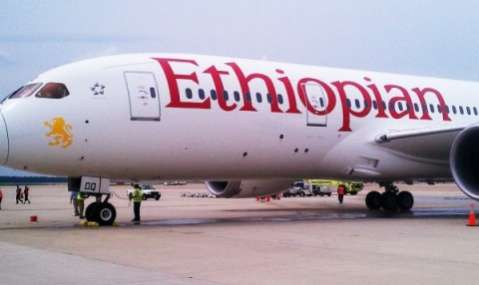Where once ancient ex-military freighters were the rule, now brand-new Boeing 777s ply the African skies. China’s hunger for natural resources and Europe’s desire for fresh produce and flowers has meant investment in Africa is booming, making it what some call the “New Eldorado.” But the legendary American City of Gold was a myth. Will a sustainable prosperity for African airfreight also be a fairy tale?
Zemedeneh Negatu, a managing partner of Ernst & Young, says no. “We are seeing the gradual shift in economic power from west to east. That isn’t a one-off, it’s a permanent trend. In 2010, North America’s share of the global gross domestic product (GDP) was 22 percent. The forecast is that by 2050 it will be 11 percent, whereas Africa will go from 4 percent to 12 percent.”
Since that prosperity, so far, comes from natural resources rather than services or manufacturing, it taps directly into a need for cargo.
“The global cargo market is experiencing a revolution,” says Lida Mantzavinou, Aerospace and Defence Consultant at Frost & Sullivan. “New trade corridors are emerging linking the markets of Africa, Latin America, Middle East and Asia, which are growing faster than Western markets. Africa’s emerging middle class, infrastructure developments and increasing foreign direct investments will eventually drive cargo traffic growth, which by 2030 is expected to grow by 5.8 percent.” She adds that by then Africa’s fleet will double to 1,210 aircraft, 60 percent being additions to existing fleets.
“The major legacy airlines are growing domestically through regional partnerships and internationally through foreign partnerships,” she explains. “Some prominent examples of this include South African Airlines strengthening its partnership with Emirates and Qantas to grow in the Middle East and Asia. Ethiopian Airlines partnered with the Togolese carrier ASKY to better serve East Africa and joined Star Alliance in order to benefit from strengthened partnerships with the alliance’s Asian members.”
Indeed, Ethiopian Airlines’ recent success parallels the continent’s own success. “2012 was a good year,” Daniel Mebrate, associate vice president, Ethiopian Cargo, told Air Cargo World. “We started operations with two new 777-200LR freighters – the first in Africa – out of six on order. We are now working to establish a cargo hub in Lomé (Togo) [for] the West Africa market to add to our existing regional hubs in Liege, Dubai, Hong Kong and Mumbai, and building a warehouse, which is slated to be, in terms of capacity, the biggest perishable warehouse in the world.”
Non-African airlines have, after some initial caution, flocked to join this new gold rush although Emirates is treating Africa’s growth as a long-term situation, rather than a temporary blip.
“We’ve seen really good growth in and out of both East and West Africa,” says Duncan Watson, vice president for Cargo Commercial Operations – Middle East, Africa and Pakistan for the Dubai-based airline. “Some of our highlights last year were the launch of our Zambia-Zimbabwe route, where we started using an A330 but upgraded to a 777, from five flights a week to daily, from October. We also delinked the flight to Entebbe and Addis. That’s given some great additional lift to both markets. We’ve also added freighter connections into Tripoli, Cairo, Djibouti, Khartoum and Lusaka. Overall we’re seeing very strong demand from all points we operate from and we’ll try and expand destinations and connections as we go into 2013. My expectations for Africa in 2013 are very positive.”
Lufthansa Cargo is also seeing solid growth, especially out of Egypt, Ethiopia and Kenya, says Hermann Zunker, regional director, Africa. That growth is attracting others, he says. “In the past year, we have seen a number of carriers expanding their network into Africa, often in line with fleet expansion and also due to softening of demand from Asia and saturation of other markets.”
The integrators are also taking note. Thomas Nieszner, CEO Europe, Middle East and Africa for DHL Global Forwarding, says DHL is planning on putting in place “unmatched access of capacity” to and from Africa using the company’s in-house carrier, StarBroker. He adds that the company is also working to develop airfreight intra-Africa primarily for its oil and gas, and mining customers in both West/Central and Southern Africa.
However, such an emerging market has its problems. Claude Picciotto, air freight procurement director for SDV Logistique International, which has a long airfreight history in Africa, says many are attracted to Africa but few have what it takes to succeed there. “Several airlines have started flying to Africa only to stop after six months,” he says. “[They] are interested in Africa because the yields are higher and with higher yields so are the margins. [They] were looking at the IATA CASS figures and thought [Africa] was the new Eldorado.”
Of those new and existing carriers to the continent, Picciotto only rates a few as having the knowledge to succeed there. “Cargolux, Air France, Avient and Allied definitely understand the market and will be reactive if the market booms in one country or region to quickly place additional capacity.”
So, why do so many fail? Local knowledge is apparently essential as the continent’s largest problems are political instability, poor infrastructure and handling facilities, and excessive regulations and bureaucracy. Any of these can lead to disruptions to smooth operations and with air cargo’s small margins, any disruption can easily lead a venture from profit to loss. Witness the many cancellations of services throughout North Africa following the Arab Spring.
In addition to these problems, Nieszner adds the need to improve overall customs regulations and cargo handling security, while Mebrate adds traffic rights. “One has to go through a long bureaucratic process before securing fifth and seventh traffic freedom rights,” he says. “As we develop the air cargo industry on the continent; countries need to ease the stringent policies which are crucial to build a conducive operating environment for airlines.”
“There has been an improvement [in professionalism and infrastructure development] in a number of the markets,” adds Watson, “but there needs to be continual improvement over the next two or three years to maintain the kind of capacity that is being brought into the markets. Places such as Kenya, Ethiopia, Uganda, need to continue to develop their handling capability in line with market growth.”
This will be essential if Africa wants its success to be sustainable in the long-term. If the industry is based on non-African companies, it will collapse if they leave. That is why, Nieszner says, he expects much of Africa’s economic growth to come from intra-regional trade. “Large demand for petroleum, oil and gas equipment, and telecommunications products is propelling the need for increased capacity and services. While growth to the traditional Europe lanes is on the decline, the Far East and Latin America is targeted as an area for huge growth.”
Mantzavinou agrees that there will be a shift away from a dependency on Europe. She expects African carriers will try to take advantage of the “New Southern Silk Road” and capture a higher percentage of the passenger and cargo traffic by expanding domestically and internationally to China, India and Latin America through partnerships.
“Dubai is already emerging as a gateway to Africa, especially for Chinese companies that are strongly investing in the region, and UAE and Chinese carriers have been increasing frequencies to the continent,” Mantzavinou says.
That does not mean that African air cargo will have to manage these developments and changes alone. “Lufthansa is already working with the stakeholders in the supply chain to develop the air cargo business and improve quality and processes,” Zunker says. “Personally, my top three wishes for the continent are: one, faster development of e-freight.
Most countries are still considerably lagging behind in its development and need to catch up in order to benefit from more transparent and cost-effective processes. Two, security and airport infrastructure needs to improve, especially in West Africa. But even in more developed countries and airports like Johannesburg, there is urgent need for upgrades and action. And three, there needs to be a wider spread of commodities being shipped from Africa. As long as the majority of exports from Africa are perishable goods with relatively low yields, operating freighter routes into Africa will remain challenging.”
Certainly more freighter utilization is something Picciotto would like to see. “More freighters would give us more solutions, but we can understand that with the economic situation the way it is, it costs a lot of money for the airline to operate freighters. If we want more capacity we need to commit with the airlines, but with the imbalance in the market today it is difficult to fix regular shipments with the kind of block space agreement airlines want.”
Watson agrees with Zunker that e-freight should be a priority. “We’re keen to push the move to e-transactions and eAWBs. There are a couple of markets where the authorities are also keen to move ahead, which is encouraging. It may not be at the pace we like but we’re seeing some better reception to the ideas, especially in the last six months.”
Whatever focus on development Africa needs, even Ethiopian’s Mebrate admits the entrance of non-African airlines to the market can be beneficial. “Africa is attracting huge capital and investment flow from all over the globe. African carriers alone may not satisfy the growing demand so, as long as there are fair, competition practices, validates the presence of carriers from other regions to develop the continent’s air cargo industry for mutual benefit.”

 JOIN DRIVERN TAXI AS PARTNER DRIVER TODAY!
JOIN DRIVERN TAXI AS PARTNER DRIVER TODAY!











